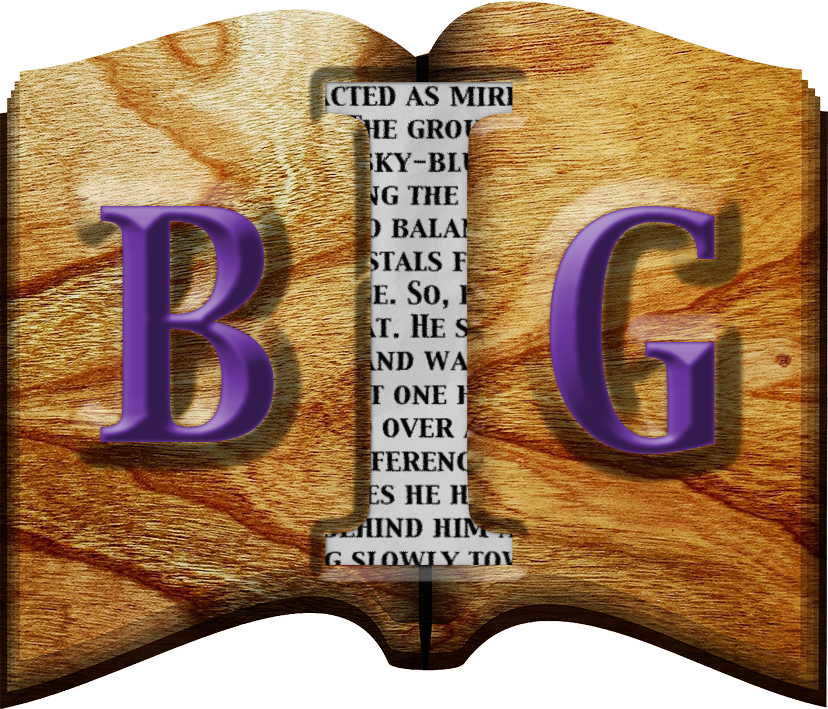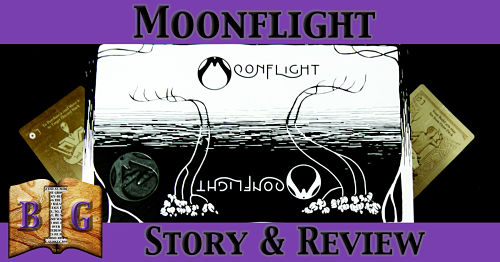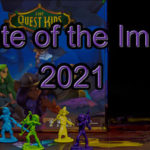Note: I was provided a complimentary copy of Moonflight for the purpose of review. The thoughts and opinions in this review are my own.
At a Glance: Moonflight
Year Published: 2020
Designer: Glenn Ford
Publisher: Man O’ Kent Games
Artists: Henry Peters
Player Count: 1-4
Editor: N/A
Suggested Age: 12+
Playing Time: 30-90 minutes
Theme: Fantasy, fae, macabre
Mechanisms: Deck building, deck un-building, hand management
Find more about Moonflight by visiting Man o’ Kent Games online on Facebook, Twitter, Instagram, Board Game Geek, and their website!
“Toss the dice until we fly,
To dance with Jak o’ the Shadows.”
― Robert Jordan, The Wheel of Time
Moonflight Intro Story: From Moonrise to Moonset
The Jack o’ Clay and Bones roamed the mercurial landscape, ever changing with the ups and downs of the moon. From one moonrise to another, the Jack o’ Clay and Bones strived to gain power—only to lose all possessions as the moon flees the sky. But what are possessions? To him, the things of the world held no value. No worth.
But not the souls of fae.
A life was ending, a new one beginning. A fae creature—humanoid in looks but so very, very different—struggled on the barren soil as the Jack o’ Clay and Bones approached. The creature sighed, knowing what his presence inevitably meant. Life set with the moon, and the time was at hand. With a nod, the Jack o’ Clay and Bones ushered the creature to follow him.
Down through the earth they went as the darkness dimmed and sunlight peaked over the horizon. As the moon fled, life bled out. The Jack o’ Clay and Bones brought the creature to the others he had collected and ferried them across the dawn to the next moonrise. Some paid what they could; others paid nothing.
Money didn’t matter to the Jack o’ Clay and Bones. Nothing mattered but allegiance and power—that’s what lasted from moonrise to moonset. As the fae disembarked to the next moonrise, those who did not—or could not—pay otherwise gave their allegiance to the Jack o’ Clay and Bones. And so his power grew in the court of the fae, built on the lives souls of unprepared travelers of the moonflight.
Overview/Roadmap
This review has two parts. First, there is the Short Review, where various aspects of the game are discussed. Then comes the Gameplay Review, in which the setup and gameplay are discussed in detail, along with initial thoughts. Following the Gameplay Review section are some final thoughts and a final verdict of the game. Feel free to jump around, or read it all in one go.
Moonflight Short Review
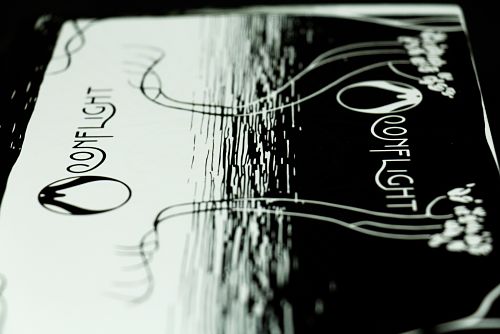
Moonflight utilizes the familiar mechanisms of deck-building games and, about halfway through the game, turns it on its head to create a game of deck deconstruction. At the end of the game, points are scored according to what is in players’ hands, so it’s important to buy good cards, but also important to get rid of any cards not worth points. It’s a neat concept and a tight balance, and Moonflight is the first I’ve seen the mechanism used this way.
Immersion
Players take control of one of the Jacks, using their asymmetrical powers to win the game. The Jack o’ Clay and Bones and the Jack o’ Words and Names are two of the Jacks in the game. And, these Jacks constantly remind me of Mat Cauthon (from The Wheel of Time) singing his song about dancing with Jack o’ the Shadows. With both the Wheel of Time and Moonflight the game seeped in lore, it’s a thematic journey that utilizes the various Jacks’ abilities appropriate to the story. While there is story and background, most of the game doesn’t necessarily utilize it, but the gameplay is still immersive as players mull over their decisions and figure out just the right time to buy or deconstruct their deck.
Theme
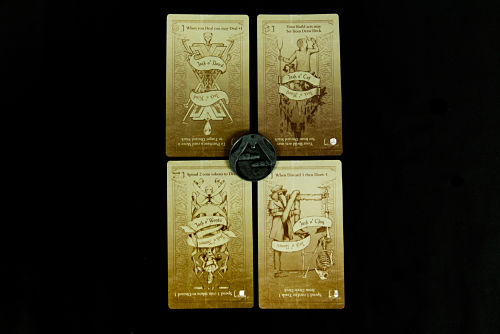
Moonflight boasts an interesting theme of fae and the oddities that surround their kind. The art plays into the creepy theme, and the abilities likewise correlate well and help pull you in.
Art & Components
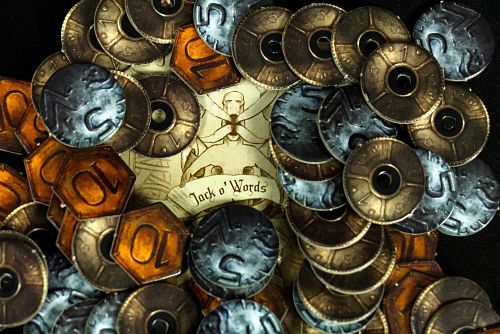
The art has an older feel to it, but does a great job of emoting a creepy vibe. I think the art really plays well with the theme, and while it is somewhat minimalist, I think anything more would actually hurt the aesthetics.
The components are mostly cards, along with cardboard tokens and a metal first-player token (which is gorgeous, by the way). The cards are tarot-sized, which is almost necessary because each card has two abilities—one on top and the other on the bottom, upside down. Approximately halfway through the game (give or take), all cards rotate to use the abilities that were previously upside down. The art, too, rotates with the cards to show additional detail once it is face up.
The cards are large, so shuffling them can be a literal handful at times, but it’s not too bad that it takes away from the gameplay.
Standout Performances
- Two (2) solo variants
- Unique un-building mechanism
- Asymmetric abilities
Breaking the 4th Wall
In theater, breaking the fourth wall refers to when characters (or something else) directly address the audience, thus pulling them out of the narrative and making the astutely aware that they are, in fact, watching a performance and that’s it’s not actually real.
I don’t feel like there’s much to complain about, which is always a nice feeling. I did feel like our first game took (and felt) longer than it should have, but that’s the nature of learning new games. Besides, subsequent plays proved things to move much faster. Also, shuffling the tarot-size cards as frequently as you do in deck builders can be troublesome for some folks due to their large size. It wasn’t really an issue for me, but it did take some getting used to. The macabre nature of the art may turn some people off as well, but I didn’t find it overly graphic in any way.
Moonflight Gameplay Review
First Impressions
The game looked slightly intimidating when I first opened it, but things came together after reading the rules. The rules took a bit to digest, but there weren’t any huge complications, and playing through it certainly helped answer questions that remained.
Setup
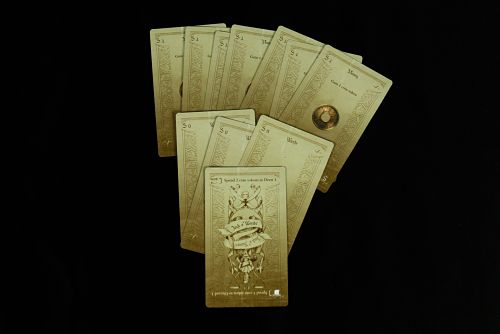
Each player selects a specific Jack and takes that Jack’s specific market cards. Then each player shuffles and deals three of these market cards in front of their play area. While these market decks are specific to their owner’s Jack, they can still be purchased and used by other players. All players have the same number of common market cards that are also laid out in front of each player. These can also be purchased by any player, so they’re not specifically yours.
All players gain five coins. Each player also takes their ten starting cards (consisting of coins and wast, which are, effectively, a waste of space) and shuffles them up, then draws five cards. You’re ready to dance with the Jacks o’ the realm!
Gameplay
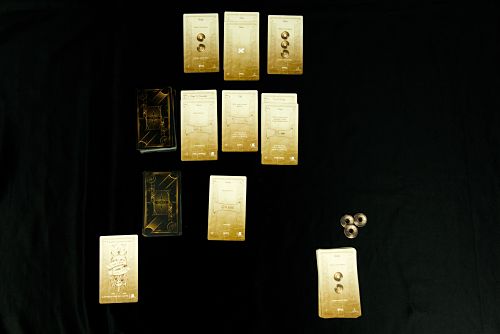
The game is played in a series of rounds. Around ends once all players have passed. Throughout the round, players take turns taking an action. They can buy a market card, play a card for its ability, use the ability of an existing card in front of them, or pass.
Much of the gameplay is what you’d expect from a deck builder—buy cards to build your deck, shuffle your discard pile when your deck is empty to create a new (and larger) deck, and rinse and repeat. But played cards in front of you have the potential to stay in-play as you place other cards from your hand face down on the played cards. Then, instead of discarding the played card at the end of the round, you discard the top-most card on the cards you played. This way you can keep those powerful cards with ongoing abilities from round to round.
Some cards are worth points before the cards rotate 180 degrees, and some are worth points after the “Turn,” as it’s called. The key is to buy cards that will let you buy more expensive cards, and finally be able to buy cards with points on them. Because, at the end of the game, you only score points for the cards in your hand. And, so, you’ll need to find a way to get rid of cards from your deck.
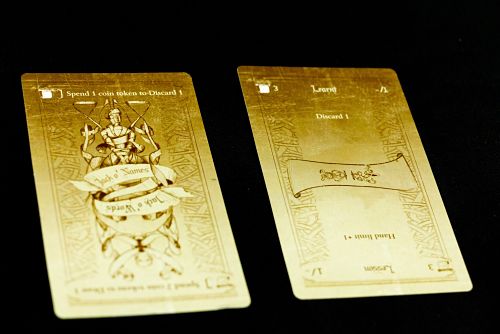
The innovative mechanism of un-building happens when the Turn takes place. After the Turn, cards that once helped you acquire cards may help you trash them (or some other method of ridding them from your deck). So there’s this neat interplay with your cards being useful in various ways, depending on which side is currently “up.”
The Turn happens when a player’s personal market deck is depleted. Then all cards rotate and new abilities emerge. Once a player has removed enough cards from their deck that their deck AND discard are depleted, the game is over. Points are scored according to the cards in each player’s hand. It’s not going to be a huge score (think maybe 4-7 points), but there will hopefully be some point cards left over. It’s important to get rid of your cards quickly, just in case someone goes out sooner than anticipated.
And, obviously, the player with the highest score wins.
Thoughts on Gameplay
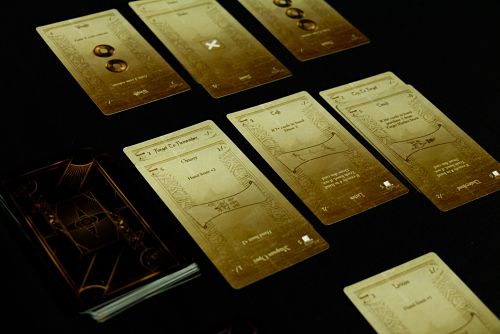
I really like Moonflight. It’s a fun deck builder with an intriguing—and unique—“twist” to it (yes, pun intended). It does take a some dedicated time to play, but it’s an engaging puzzle as you continually craft your deck to your liking and then meticulously trim it back.
The gameplay is a lot of players buying cards from their own markets and managing their own decks. Occasionally, another player will buy a card from an opponent’s marker (this could be to keep that player from getting the card, to help themselves, or to speed up the Turn). After the turn, it really becomes a race to weed out your deck of useless cards the fastest. Savvy hand management is what you’re looking for here.
Solo Play
I love that there’s not just one, but two solo variants, one playing for points (beat your high score!) and the other against an artificial intelligence. I’d had a lot of fun playing this solo, and the variety of solo modes helps keep things fresh. And, I find that playing solo also goes quicker, so if you want to play but can’t commit the full time, solo is a great option.
Moonflight: Final Thoughts
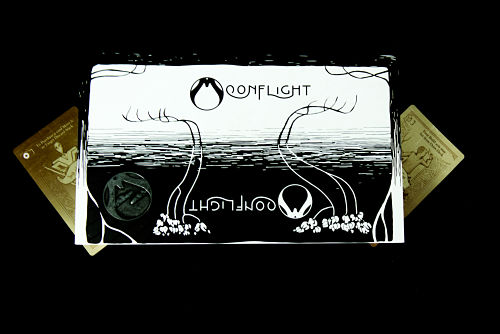
Moonflight is a lot of fun. It’s familiar but different, simple yet complex. If you want something new in your deck building, Moonflight is here to help. Whether you’re playing with other humans or taking it solo, Moonflight is an engaging, thoughtful experience.
Final Verdict
Now, the moment of truth! You’ve read the review, you know my thoughts and feelings, so with that knowledge in mind, you can better understand why I am rating it what I am. Remember that your ranking might be higher or lower than mine. Huzzah for personal preferences and opinions!
With all that said, I am dropping the gavel and giving a final verdict of Two Captivating Thumbs. It plays well, the deck un-building is a neat twist, and the two solo variants are all aspects that raise the game’s ranking for me. It’s a super-solid game, and if you’re into deck building, you really aught to give Moonflight a try.
Like This, Like That
This section is here to help you compare this game with other games you may be familiar with.
If you like Dominion, the grandfather of deck builders, then there’s a good chance you’ll like Moonflight. Likewise, if you enjoy games that utilize multi-use cards, Moonflight uses that well.
Verdict Scale (Lowest to Highest)
The Final Verdict is based on a scale of 1-7, although this scale is not numbered. Instead, it uses thematically appropriate words to describe the performance of the game.
Tomatoes – This game was emotionally taxing and difficult to finish.
Uninspiring – This game had me daydreaming about other games.
Lackluster – This game had its moments, but it probably won’t see much table time.
Laodicean – This game is decent. It works. There’s a reason people like it.
Two Thumbs Up – This game is pretty dang good.
Captivating – This game is outstanding! It’s more than good; it’s practically a staple.
Standing Ovation – This is the best game you will ever play. Period.
Read short fiction inspired by board games at BGI’s stories page!
Visit Man o’ Kent Games on Facebook, Instagram, Twitter, and at their website.
